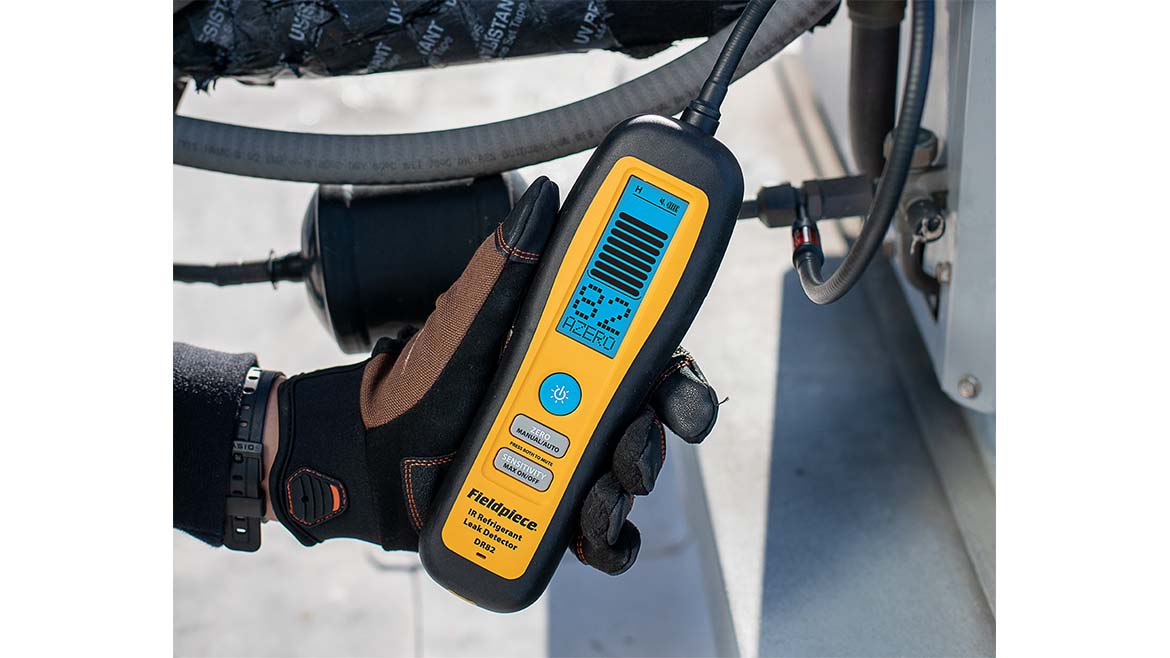Okay, we know soap bubbles are the traditional method for refrigerant leak detection on HVACR systems and they can be a very tried and true indicator. But, when you need to pinpoint micro-leaks fast, an electronic detector with a higher sensitivity than bubbles can be the ticket.
The four main types of electronic leak detectors available to HVACR techs include: heated diode, corona discharge, infrared, and ultrasonic. The following is a snapshot of how the different technologies work and the ins and outs of each to help you determine which is the best fit for your toolkit.
Heated Diode Detectors
With a heated diode detector, sampled air is heated to a high temperature, ionizing halogenated refrigerant gases. The resulting charged chlorine and fluorine ions, even in trace amounts, generate current through the diode which then triggers an alarm. Heated diodes detect leaks of HFC, CFC, HCFC, HFO, H2N2 (Tracer Gas), and other refrigerant blends. The Fieldpiece DR58 Heated Diode Leak Detector performs particularly well with R410A and sniffs refrigerant leaks as small as 0.03 oz/yr – that’s 20 times more sensitive than soap bubbles.
Heated diode detectors are not prone to false alarms, but their sensor life may be affected by excessive refrigerant exposure and contaminants like oil. The sensor should be checked regularly with a calibrated reference leak. It is recommended to replace the Fieldpiece DR58 sensor after approximately 300 hours of use.
Corona Discharge Detectors
In a process similar to heated diode detectors, corona discharge detectors also react to a change in current flow from ionized gases. However, they pull sample air through an electrical field around an electrode. Gases are broken down by the electric arc (corona discharge), causing a change in electrode current which then signals a leak.
False alarms can occur with corona discharge detectors because they do not trigger on specific refrigerant compounds. Response times are slightly slower than heated diodes and corona sensor life can be as short as 24 hours of use.
Infrared Leak Detectors
Infrared detectors shine a beam of infrared (IR) waves through potentially contaminated air to detect and analyze trace amounts of refrigerant and signal a leak. Because light absorption in the IR spectrum is gas-specific, they are the least susceptible to false-positive alarms and are considered highly accurate across all refrigerant types. Infrared detectors also have the edge with newer refrigerants that contain less chlorine and fluorine, the trigger for heated-diode sensors.
When considering the cost of ownership of a leak detector, the long life of the infrared sensor will factor into the equation. For example, the sensor life is approximately 10 years for the Fieldpiece DR82 Infrared Leak Detector.
Ultrasonic Leak Detectors
An ultrasonic leak detector is also known as a “listening detector.” When refrigerant escapes from a pressurized system, it creates tiny sound fluctuations in the form of high-frequency sound waves that the sensor picks up.
These detectors can hear very small leaks on high-pressure systems and their sensors last for a long time. However, when a system has low pressure, these detectors are not as accurate or effective. Ultrasonic leak detectors can also be affected by job site noise.
Techs have multiple options when looking for electronic leak detection tools, including heated diode, corona discharge, infrared, and ultrasonic. While each has its merits, the tool that’s right for you will depend on the refrigerants you work with now and expect to work with in the future, the accuracy desired, and your sensitivity to the overall cost of ownership. An electronic leak detector is an investment that makes your job easier, so it’s worth the homework to figure out which one needs a spot in your tool bag.
This guest column is courtesy of Fieldpiece Instruments.
Whether you require installation, repair, or maintenance, our technicians will assist you with top-quality service at any time of the day or night. Take comfort in knowing your indoor air quality is the best it can be with MOE heating & cooling services Ontario's solution for heating, air conditioning, and ventilation that’s cooler than the rest.
Contact us to schedule a visit. Our qualified team of technicians, are always ready to help you and guide you for heating and cooling issues. Weather you want to replace an old furnace or install a brand new air conditioner, we are here to help you. Our main office is at Kitchener but we can service most of Ontario's cities
Source link




Add Comment